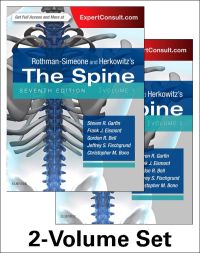Rothman-Simeone: The Spine (7th Edition)
Section 1: Basic Science
1. Development of the Spine
2. Applied Anatomy of the Spine
3. Architectural Design and Function of Human Back Muscles
4. Lumbar Musculature: Anatomy and Function
5. The Intervertebral Disc-Normal, Aging, Pathologic (Chemical-Anatomic)
6. Biomechanics of the Spinal Motion Segment
7. Sciatica and Nerve Root Pain in Disc Herniation and Spinal Stenosis: A Basic Science Review and Clinical Perspective
8. Basic Concepts in Genetics and Interverteral Disc Degeneration and Scoliosis
9. Twin Studies Relevance to Genetic and Environmental Influences
10. Outcomes Research for Spinal Disorders
11. Finite Element Modeling: An Overview and Clinical Relevance
Section 2: Diagnosis
12. The Patient History and Physical Examination: Cervical, Thoracic and Lumbar
13. Spine Imaging
14. The Electrodiagnostic Examination
15. Intraoperative Neurophysiologic Monitoring of the Spine
16. Targeting "Pain Generators"
17. Discography
Section 3: Surgical Anatomy and Approaches
18. Cervical Spine: Surgical Approaches
19. Thoracic Spine: Surgical Approaches
20. Posterior-Lateral Approaches
21. Lateral Approaches
22. Anatomy and Non-Operative Results, Pre-Operative Injections, Rx
23. SI Joint Surgery
24. Outcomes Perspectives
Section 4: Pediatrics
25. Back Pain in Children and Adolescents
26. Congenital Scoliosis
27. Idiopathic Scoliosis
28. Neuromuscular Scoliosis
29. Thoracoscopic Techniques
30. Pediatric Kyphosis: Scheurmann's Disease and Congenital Deformity
31. Spondyloysis and Spondylolisthesis
32. Cervical, Thoracic and Lumbar Spinal Trauma of the Immature Spine
33. The Immature Spine and Athletic Injuries
34. Congenital Anomalies of the Cervical Spine
35. Congenital Anomalies of the Spinal Cord
Section 5: Cervical Degenerative Disorders
36. Cervical Spinal Disorders Associated with Skeletal Dysplasias and Metabolic Diseases
37. Pathophysiology, Natural History and Clinical Syndromes of Cervical Disc
38. Medical Myelopathies
39. Nonoperative Management of Disc and Degenerative Disorders
40. Surgical Management of Axial Pain
41. Cervical Radioculopathy: Surgical Management
42. Management Cervical Myelopathy: Surgical Management
43. Ossification of the Posterior Longitudinal Ligament (OPLL)
44. Cervical Disc Replacement
Section 6: Thoracic and Lumbar Disc Disease
45. Thoracic Disc Disease: Clinical and Surgical Management
46. Lumbar Disc Disease: Overview of Clinical Problem
47. Lumbar Disc Herniations
48. Annulus Repair
49. Lumbar Disc Degeneration: Anterior Lumbar Interbody Fusion, Degeneration and Disc/Replacement
50. Lumbar Disc Degeneration: Posterior Lumbar Interbody Fusion (Anterior)
51. Posterolateral & Lateral Corpectomies
52. Dynamic Stabilization: What's Current, What's the Potential
Section 7: Minimally Invasive Surgery
53. Rationale of MIS Surgery
54. Minimally Invasive (Posterior) Surgical Approaches to the Spine
55. MIS Posterior Lumbar Instrumentation
56. MIS Posterior Lumbar Fusion Techniques
57. Endoscopic Lumbar Surgery
58. Interspinous Spacers
59. MIS Cervical Surgery Techniques
60. Future Direction in MIS Spinal Surgery
Section 8: Spinal Stenosis
61. Spinal Stenosis: Pathophysiology, Clinical Diagnosis, Differential Diagnosis
62. Nonoperative Management Of Lumbar Spinal Stenosis
63. Surgical Management of Lumbar Spinal Stenosis
64. Degenerative Spondyolisthesis
Section 9: Spinal Fusion and Instrumentation
65. Techniques and Complications of Bone Graft Harvesting
66. Principles of Bone Fusion
67. Bone Substitues: Basic Science and Clinical Application
68. Electrical Stimulation of Spinal Fusion
69. Cervical Instrumentation: Anterior and Posterior
70. Thoracic and Lumbar Instrumentation: Anterior and Posterior
Section 10: Adult Deformity
71. Isthmic Spondylolisthesis
72. Adult Scoliosis
73. Fixed Sagittal Imbalance
Section 11: Spine Trauma
74. Basic Science of Spinal Cord Injury
75. Injuries of the Upper Cervical Spine
76. Injuries of the Lower Cervical Spine
77. Thoracic and Lumbar Spinal Injuries
78. Sacral Fractures
79. Acute Treatment of Patients with Spinal Cord Injury
80. Vertebral Artery Injuries Associated with Cervical Spine Trauma
81. Spinal Orthoses for Traumatic and Degenerative Disease
82. Spinal Cord Injury Rehabilitation
Section 12 Afflictions of the Vertebrae
83. Arthritis Disorders
84. Surgical Management of Rheumatoid Arthritis
85. Ankylosing Spondylitis
86. Tumors of the Spine
87. Infections of the Spine
88. Metabolic Bone Disorders of the Spine
89. Osteoporosis: Surgical Strategies
Section 13: Spinal Cord
90. Intradural Tumors
91. Spinal Intradural Infections
92. Vascular Malformations of the Spinal Cord
93. Vascular Anatomy of the Spine, Imaging and Endovascular Treatment of Spinal Vascular Diseases
94. Syringomyelia
Section 14: Complications of Spinal Surgery
95. Intraoperative-Postoperative Nerve and Spinal Cord Injuries
96. Spinal Dural Injuries
97. Vascular Complications in Spinal Surgery
98. Instrumentation Complications
99. Postoperative Spinal Infections
100. Pseudarthrosis
101. Transitional
102. Failed Back Surgery Syndrome
Section 15: Failed Surgery
103. Revision Surgery
104. Failed Disc Replacement
105. Postoperative Cervical Deformity of the Spine
106. Arachnoidditis/Epidural Fibrosis
Section 16: Chronic Pain/Rehabilitation
107. Chronic Pain: The Basic Science
108. Psychologic Strategies for Chronic Pain
109. Pharmacologic Strategies in Back Pain and Radiculopathy
110. Physical Therapy: The Science
111. Functional Restoration
112. Surgical Procedures for the Control of Chronic Pain




